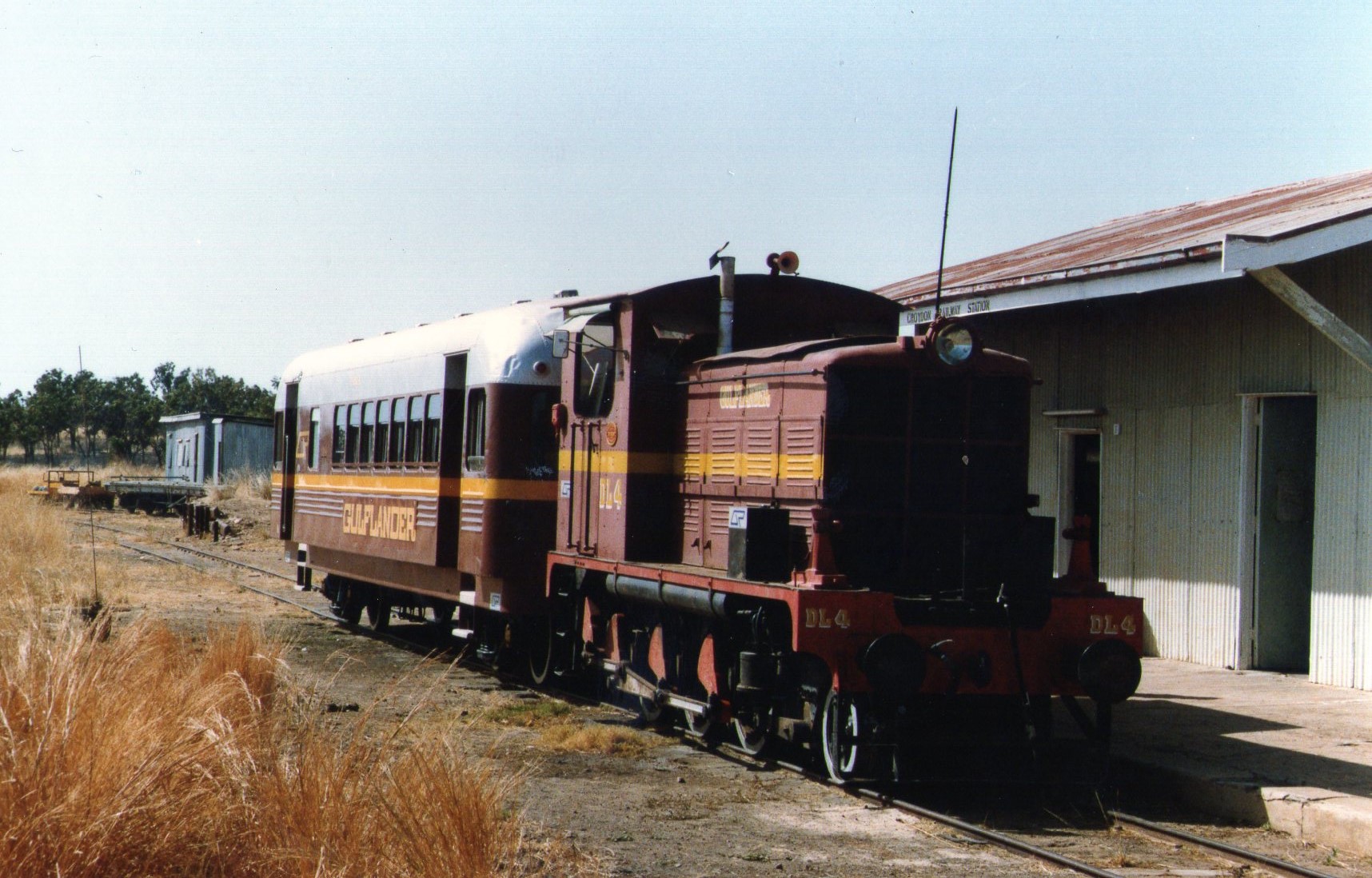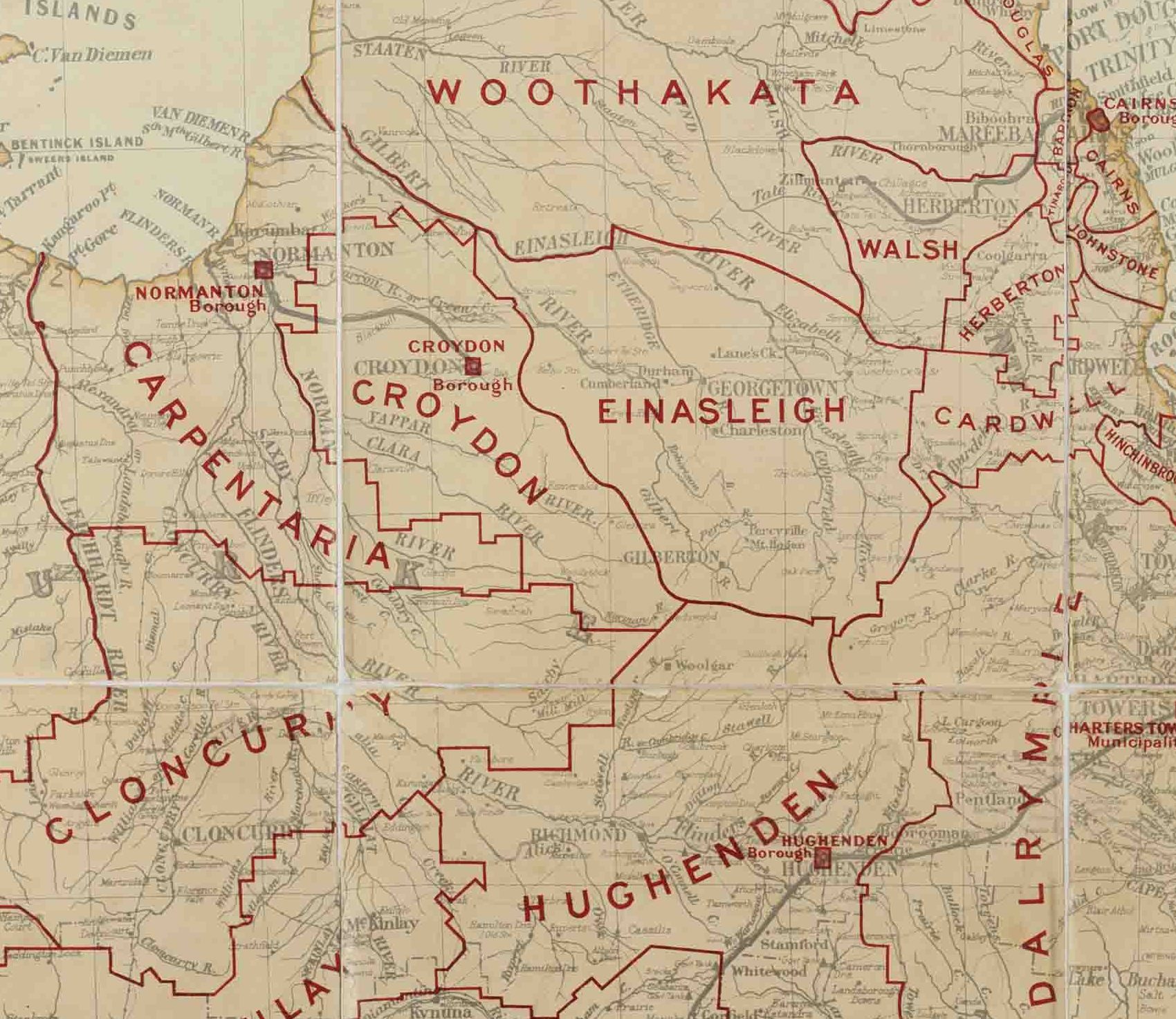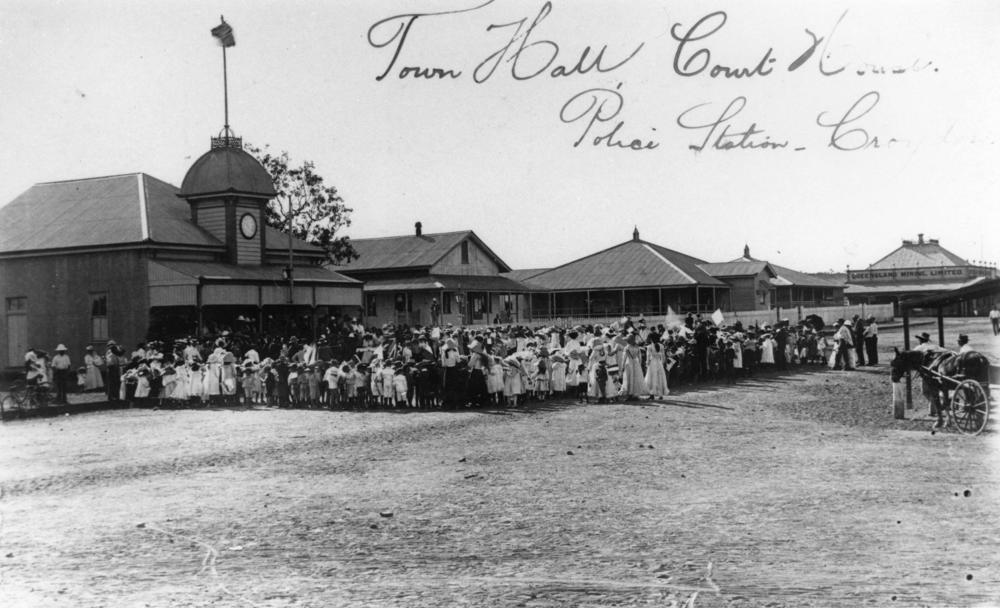|
Queensland Railways DL Class
The DL class was a class of diesel locomotive built by Queensland Railways, Robert Stephenson and Hawthorns and Walkers Limited for Queensland Railways between 1939 and 1961. History The DL class provided the first diesel locomotive in service in Queensland, DL 1 being built to provide a light weight (maximum axle load) locomotive for the Mt Surprise – Forsayth section of the line from Mareeba, which since cyclonic rainfall in 1927 severely damaged the line, had only been able to support a rail motor hauling 1 or 2 goods wagons.QGR/Stephenson-Hawthorns/Walkers – DL Class Queensland's Railway Interest Group DL1 was built by |
Workshops Rail Museum
The Workshops Rail Museum is a railway museum in Ipswich, Queensland, located within the former North Ipswich Railway Workshops. The museum Opening in September 2002 as part of the Queensland Museum Network, The Workshops Rail Museum tells the story of more than 150 years of rail in Queensland. The museum experience is made up of 15 interactive exhibitions with locomotives and beautifully restored carriages on display, children's interactive indoor playground, train simulators and model railway. The museum is housed in the original Boilershop, part of the historic North Ipswich Railway Workshops site. Museum highlights: * A10 – The A10 is the oldest working locomotive in Australia built in 1865. * Deconstructed Diesel Locomotive – A cut away displaying everything from bogies to batteries and axles to auxiliary generators of a diesel locomotive. * Train Simulator – Step inside a diesel locomotive cab and drive a train in the diesel simulator. * Vice Regal Carriage – ... [...More Info...] [...Related Items...] OR: [Wikipedia] [Google] [Baidu] |
Switcher
A switcher, shunter, yard pilot, switch engine, yard goat, or shifter is a small railroad locomotive used for manoeuvring railroad cars inside a rail yard in a process known as ''switching'' (US) or ''shunting'' (UK). Switchers are not intended for moving trains over long distances but rather for assembling trains in order for another locomotive to take over. They do this in classification yards (Great Britain: ''marshalling yards''). Switchers may also make short transfer runs and even be the only motive power on branch lines and switching and terminal railroads. The term can also be used to describe the workers operating these engines or engaged in directing shunting operations. Switching locomotives may be purpose-built engines, but may also be downgraded main-line engines, or simply main-line engines assigned to switching. Switchers can also be used on short excursion train rides. The typical switcher is optimised for its job, being relatively low-powered but with a high ... [...More Info...] [...Related Items...] OR: [Wikipedia] [Google] [Baidu] |
Railway Locomotives Introduced In 1939
Rail transport (also known as train transport) is a means of transport that transfers passengers and goods on wheeled vehicles running on rails, which are incorporated in tracks. In contrast to road transport, where the vehicles run on a prepared flat surface, rail vehicles (rolling stock) are directionally guided by the tracks on which they run. Tracks usually consist of steel rails, installed on sleepers (ties) set in ballast, on which the rolling stock, usually fitted with metal wheels, moves. Other variations are also possible, such as "slab track", in which the rails are fastened to a concrete foundation resting on a prepared subsurface. Rolling stock in a rail transport system generally encounters lower frictional resistance than rubber-tyred road vehicles, so passenger and freight cars (carriages and wagons) can be coupled into longer trains. The operation is carried out by a railway company, providing transport between train stations or freight customer facilit ... [...More Info...] [...Related Items...] OR: [Wikipedia] [Google] [Baidu] |
Queensland Rail Locomotives
) , nickname = Sunshine State , image_map = Queensland in Australia.svg , map_caption = Location of Queensland in Australia , subdivision_type = Country , subdivision_name = Australia , established_title = Before federation , established_date = Colony of Queensland , established_title2 = Separation from New South Wales , established_date2 = 6 June 1859 , established_title3 = Federation , established_date3 = 1 January 1901 , named_for = Queen Victoria , demonym = , capital = Brisbane , largest_city = capital , coordinates = , admin_center_type = Administration , admin_center = 77 local government areas , leader_title1 = Monarch , leader_name1 = Charles III , leader_title2 = Governor , leader_name2 = Jeannette Young , leader_title3 = Premier , leader_name3 = Annastacia Palaszczuk ( ALP) , legislature = Parliament of Queensland , judiciary = Supreme Court of Queensland , national_representation = Parliament of Australia , national_representation_type1 = ... [...More Info...] [...Related Items...] OR: [Wikipedia] [Google] [Baidu] |
Robert Stephenson And Hawthorns Locomotives
The name Robert is an ancient Germanic given name, from Proto-Germanic "fame" and "bright" (''Hrōþiberhtaz''). Compare Old Dutch ''Robrecht'' and Old High German ''Hrodebert'' (a compound of '' Hruod'' ( non, Hróðr) "fame, glory, honour, praise, renown" and ''berht'' "bright, light, shining"). It is the second most frequently used given name of ancient Germanic origin. It is also in use as a surname. Another commonly used form of the name is Rupert. After becoming widely used in Continental Europe it entered England in its Old French form ''Robert'', where an Old English cognate form (''Hrēodbēorht'', ''Hrodberht'', ''Hrēodbēorð'', ''Hrœdbœrð'', ''Hrœdberð'', ''Hrōðberχtŕ'') had existed before the Norman Conquest. The feminine version is Roberta. The Italian, Portuguese, and Spanish form is Roberto. Robert is also a common name in many Germanic languages, including English, German, Dutch, Norwegian, Swedish, Scots, Danish, and Icelandic. It can be used ... [...More Info...] [...Related Items...] OR: [Wikipedia] [Google] [Baidu] |
Diesel Locomotives Of Queensland
Diesel may refer to: * Diesel engine, an internal combustion engine where ignition is caused by compression * Diesel fuel, a liquid fuel used in diesel engines * Diesel locomotive, a railway locomotive in which the prime mover is a diesel engine Arts and entertainment * Diesel (band), a Dutch pop/rock group * ''Diesel'' (1942 film), a German film about Rudolf Diesel * Diesel (2022 film), an Indian Tamil language thriller film * Diesel (game engine), a computer gaming technology * Diesel, a former name of Brazilian rock band Udora People Surname * Nathanael Diesel (1692–1745), Danish composer, violinist and lutenist * Vin Diesel (Mark Sinclair, born 1967), American actor, producer and director * Rudolf Diesel (1858-1913), German inventor and mechanical engineer Nickname or ring name * Diesel (musician) (Mark Lizotte, born 1966), American-Australian rock singer-songwriter * Kevin Nash (born 1959) ring name and gimmick for American professional wrestler Kevin Nash while p ... [...More Info...] [...Related Items...] OR: [Wikipedia] [Google] [Baidu] |
Rosewood, Queensland
Rosewood is a rural town and locality in the City of Ipswich, Queensland, Australia. In the , the locality of Rosewood had a population of 3,263 people. Rosewood is in the Bremer Valley. Geography The town of Rosewood is located south-west of the Brisbane CBD. Part of the town's border is marked by the Bremer River to the south, and the decommissioned Marburg branch railway line on the Little Liverpool Range to the north. Perrys Knob is a hill (), rising above sea level. It takes its name from the Perry family who owned land containing the know and its western slopes. The Main Line railway enters the locality from the east ( Thagoona) and exits to the west ( Lanefield). The locality had a number of railway stations (from west to east): * Rosewood railway station, serving the town () * Yarrowlea railway station, now abandoned () There were two railway stations on the now-closed Marburg branch railway line (from north to south): * Perrys Knob railway station, now disamant ... [...More Info...] [...Related Items...] OR: [Wikipedia] [Google] [Baidu] |
Australian Railway Historical Society
The Australian Railway Historical Society (ARHS) aims to foster an interest in the railways, and record and preserve many facets of railway operations. It had divisions in every state and the Australian Capital Territory, although the ACT division was wound up in 2016, along with the Victorian division in 2020. Since 1967, when each division incorporated, the state divisions have operated as separate entities. Each still trades under the ARHS brand, except in Western Australia, where the division is called Rail Heritage WA. Individual membership exceeds 2,500. Background The ARHS was founded in Sydney in 1933 as The Railway Circle, becoming the Australasian Railway and Locomotive Historical Society shortly afterwards. The society's name was changed to the present form in 1952. Divisions were later formed in most states, most of which established a railway museum, namely: *ACT - Canberra Railway Museum, Kingston *Queensland - Rosewood Railway Museum *South Australia - SteamRang ... [...More Info...] [...Related Items...] OR: [Wikipedia] [Google] [Baidu] |
Mount Surprise, Queensland
Mount Surprise is a rural town and locality in the Shire of Etheridge, Queensland, Australia. In the , the locality of Mount Surprise had a population of 169 people. Geography The town is located in the Gulf Savannah in Far North Queensland on the Gulf Developmental Road, north west of the state capital, Brisbane and west of the regional centre of Cairns. History The town was founded by Ezra Firth, from the English county of Yorkshire, who along with his family settled in the area in 1864. The property struggled at first; relations with the indigenous inhabitants of the country were hostile and the country was not suited for wool growing. The discovery of gold in the 1880s and the subsequent gold rush allowed Firth to sell his sheep to the miners, convert his holding to cattle and become wealthy selling goods to the miners. In 1908, the Etheridge railway line reached Mount Surprise. Mount Surprise Post Office opened by July 1908. Mount Surprise State School opened on ... [...More Info...] [...Related Items...] OR: [Wikipedia] [Google] [Baidu] |
Shire Of Etheridge
The Shire of Etheridge is a local government area in Far North Queensland, Australia in what is known as the Savannah Gulf region. Its economy is based on cattle grazing and mining. It covers an area of , and has existed as a local government entity since 1882. History The Einasleigh Division was created on 11 November 1879 as one of 74 divisions around Queensland under the ''Divisional Boards Act 1879'' with a population of 720. In 1891 it was reported that the divisional board had made no progress, perhaps because it covered a large area that was sparsely settled. With the passage of the ''Local Authorities Act 1902'', Einasleigh Division became the Shire of Einasleigh on 31 March 1903. On 15 March 1919, it was renamed Shire of Etheridge. Towns and localities The Shire of Etheridge includes the following settlements: * Georgetown * Einasleigh * Forsayth * Gilbert River * Mount Surprise * Abingdon Downs * Conjuboy * Gilberton * Lyndhurst * Northhead * Strat ... [...More Info...] [...Related Items...] OR: [Wikipedia] [Google] [Baidu] |
Croydon, Queensland
Croydon is a town and Suburbs and localities (Australia), locality within the Shire of Croydon in Queensland, Australia. It is a terminus for the Normanton to Croydon railway line, which operates the Gulflander tourist train. At the , Croydon had a population of 258 people. History The historic goldrush town of Croydon is located in the heart of the Gulf Savannah, west of Cairns. Mining in the area quickly drove out the Tagalag people, Tagalaka people indigenous to the area. Croydon was a large pastoral holding owned by Alexander Brown and Margaret Chalmers that covered an area of approximately , when first settled in the 1880s. The town's name is derived from a pastoral run name, that was used by their sons, Alexander Brown and William Chalmers Brown, pastoralists; William Chalmers Brown was born in Croydon, England in 1841 and is buried at Toowong Cemetery, Toowong cemetery in Brisbane. Gold was discovered in 1885 and by 1887, the town's population had reached 7,000. Croydon P ... [...More Info...] [...Related Items...] OR: [Wikipedia] [Google] [Baidu] |






